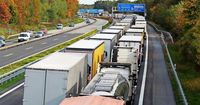On March 26, 2025, drivers in several regions of Germany faced severe traffic congestion due to ongoing construction projects, accidents, and high volume on key roads. The latest reports from Lübeck, Dahme-Spreewald, Marburg, Remscheid, Solingen, and Gifhorn shed light on the current traffic scenarios, warning motorists to exercise caution and prepare for delays.
In Lübeck, the traffic situation is notably challenging, particularly along highways A1 and A7, which are frequently congested, especially during tourist peak times. As reported by ADAC, the A1 connects the coastal areas with Hamburg, but is plagued by delays. The traffic updates are powered by TomTom, which aggregates data from several million GPS devices, including mobile phones and municipal road sensors, providing real-time updates to travelers.
Dahme-Spreewald, another region experiencing traffic slowdowns, has reported problematic routes including the A10, A12, A13, and several federal roads. Notably, the A10 is experiencing congestion from the southern and eastern rings, extending as far as the Polish border. Local drivers are urged to stay informed through traffic updates, which are refreshed every five minutes.
In a similar situation, Marburg and its surrounding areas reported slow progress on major routes including federal roads B3, B62, and B236, which are vital for commuters. The source of the data remains consistent across regions, utilizing TomTom to draw from the extensive network of data collected through modern technology.
Remscheid faces significant traffic challenges as the A1 and A46 are identified as top congestion hotspots according to recent ADAC reports. The A1 created approximately 6,500 hours of traffic jams last year between Cologne and Dortmund, while the A46 also ranks high in congestion throughout North Rhine-Westphalia, affecting travel toward Düsseldorf.
Solingen's situation is no different, as it shares key traffic routes with Remscheid and Wuppertal, including the A3, which is notorious for delays. In 2023, the section between Cologne and Oberhausen logged over 10,000 hours of traffic congestion. Ongoing construction at the Solingen interchange further exacerbates the problem.
In Gifhorn, traffic is significantly slowed on the A2 and A39 highways. The road conditions are monitored through TomTom's services, which maintain accuracy by compiling data from millions of mobile devices, ensuring that motorists are adequately informed of their travel conditions.
As travelers navigate these heavily trafficked areas, they'll find themselves at the mercy of construction work and accidents, which consistently lead to slower travel times. It's crucial for all drivers to remain vigilant and patient while sharing the road with others.
TomTom's role in this traffic monitoring initiative highlights the increasing reliance on technology for everyday logistics, granting drivers access to real-time data that can help them make informed decisions. Updating every five minutes, these insights provide a vital service for motorists looking to avoid delays and detours.
With tourist seasons approaching, the highways are expected to experience even heavier traffic loads. As such, authorities continuously remind drivers to adhere to safety measures, exercise caution, and remain considerate towards fellow travelers. The cooperation between local traffic services and technology companies like TomTom is crucial for implementing safer driving conditions in these congested areas.
Navigating the roads of Lübeck, Dahme-Spreewald, Marburg, Remscheid, Solingen, and Gifhorn demands not just awareness of personal safety, but responsiveness to the flow of traffic at large. As patterns change and road conditions evolve, staying updated with reliable resources will enable motorists to approach their daily drives with confidence.
Ultimately, the traffic woes felt across these regions can be mitigated by utilizing available technology to remain informed about current conditions. All drivers are encouraged to check real-time updates before embarking on their journeys, ensuring they are well-prepared to face any delays while on the road.
As accidents, roadwork, and volume combine, the message remains steadfast: keep safety at the forefront of your travel plans!









